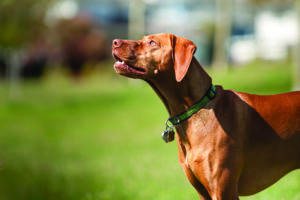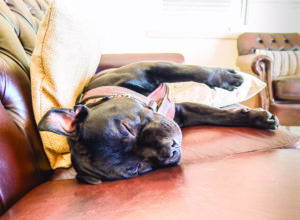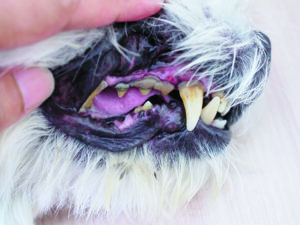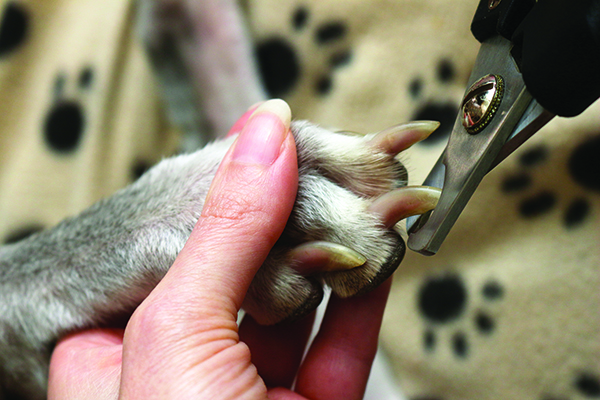If there were something simple you could do that would make your dog much happier, you’d do it in a flash, right?
Every day I see owners going to great lengths, and spending small fortunes, to indulge their dogs. That’s why I’m perplexed when I see those very same folks ignoring the smaller, easy-to-rectify issues that diminish their dog’s daily quality of life, causing anything from mild irritation to major pain.
Marketers may sell us on products for our dogs: expensive food and treats, beds, and toys. But some of the most important keys to our dogs’ happiness are free or low-ticket items that nobody advertises – so they can often go under the radar. Here are five simple things that you can fix to greatly improve your dog’s quality of life:
1. LONG NAILS. Ready for the hard truth? You need to be clipping or grinding your dog’s nails every three weeks.
I know. Your dog hates it. You hate it. So you put it off, and ask the vet or groomer to do it whenever your dog goes in. Unfortunately, unless you’re in the habit of monthly visits, that’s not nearly enough.
Here why too-long nails have a giant impact on your dog’s day and can become a true emergency:
* Each step your dog takes on those nails puts inappropriate pressure on the toes. That makes them twist unnaturally – and hurts!
* The pain causes dogs to compensate by adjusting their posture. That can cause orthopedic issues and can eventually be the source of hind-end weakness/soreness.
* Long nails give dogs even less grip on slippery wood or tile floors, increasing the likelihood of muscle strain. This is particularly hard on older dogs who’ve lost muscle tone. Imagine trying to walk across an ice-skating link wearing shoes with a smooth sole. That’s how your dog feels on slippery floors!
With a few exceptions, if a dog’s nails are clicking on the floor, it’s time. And if you’re thinking that’s not true for your own dog because clipping that short would absolutely mean cutting the quick, I have more bad news for you. The quick – the nerve inside the nail that bleeds when you cut it – grows along with the nail. So if you let the nails get too long, the quick gets too long, too.
The only remedy is an intense phase of even more frequent trimming! The quick always recedes back from the edge of the nail. After six weeks or so of weekly careful trimming, you should have a quick short enough that you can keep those nails from clicking on the floor.
Maybe you’ve always known how important nail trimming is but want to leave it to the “experts” because you still remember that time you cut a nail too short and made it bleed? My own “Aha!” moment came when my daughter interned at the local vet, and let me know that there is not some kind of perfect nail magic happening in that back room. Instead, they do their best, and sometimes they mess up. The difference is that you don’t see it happen and they use styptic to stop the bleeding. It’s a pain-free experience – but only for you.
That information was huge to me. I realized I was putting my dogs through extra stress so that I could avoid the drama myself. I decided that if this is to be done every three weeks, surely it’s better for my dogs to experience it with me, in the comfort of their own home. So, I worked on this skill; it’s not brain surgery! I’m pretty good at it now, and you can be, too. Here’s what will help:
* Make sure your clippers are sharp! Dull blades compress the nail before they cut through and so they can cause discomfort, even when the quick isn’t nipped. As soon as you notice that they require more force to snip through your dog’s nails, buy some new ones. I buy new clippers regularly since I clip a lot of dogs.
* Try a grinder! I was always afraid of these but have come to adore this option which leaves the nails with nice soft edges and avoids the possibility of cutting the quick with a single snip. (For more tips on using grinders, see “Grinders vs. Clippers,” WDJ October 2020.)
* Take the time to condition your dog to the experience. Pair even just the sight of the clippers or the sound of the grinder with something delicious. Dried fish! Feta cheese! Do that as frequently as you have to until you see that happy head swivel at the sight of the tool. Next step: Touch the tool to the paw, then treat. A baby-step approach can work wonders. While this may sound like it will take tons of time and patience, each interaction like this takes only seconds.
* Start small. Remember there’s no rule that you have to do all of the nails at once. With some dogs, I do two nails and call it a day.
I implore you to work on this. You’ll screw up at first and you’ll want to give up. Stick with it because the more you do it, the better you get. And once you are skilled, you’re going to hit that every-three-weeks mark. It may never be your favorite part of the day, but you and your dog can get to the point where you don’t dread it. The sooner you get brave and learn to deal with this, the sooner your dog will find walking to be much more comfortable.

2. CLINKING TAGS. Does the sound of your dog’s clinking tags ever bug you? Now imagine those tags were around your own neck 24/7, and you had incredibly acute hearing. Sad, right?
Sure, maybe most dogs get used to it. But why in the world should they? There are fantastic products out there that make clinking tags a torture device of the past.
Before you examine those new options, take the easiest step: simply reduce the number of jingling objects. Remove outdated license or rabies tags, and ponder whether you really need that rabies tag. Most counties do not require them as the license itself indicates an up-to-date vaccination history.
Once you’ve minimized the number of tags, it’s time to make them quieter. One option is to bundle them so that they don’t bang against each other. Plenty of do-it-yourselfers have always done this using rubber bands or electrical tape. Sure, it’s not easy to get to those tags, but if your dog never gets lost nobody will ever need to read them! However, if you’re looking for a cuter option, there are now great little pouches that can slip on, and wrap those tags together in silence.
Another thought is to take advantage of silicone. You can opt for a silicone ID tag rather than a metal one, or buy rubbery silencers that fit around the edge of the tags. Easily available online, they come in all sorts of colors and in the typical tag shapes.
Finally, there’s the no-dangling-ID-tag approach. There are slide-on tags that loop over the collar and lay flat. (I use these, with our generic family ID information, for my foster dogs, because I can easily move them from collar to collar.) You can also order a custom collar with ID information either engraved on a metal plate that’s riveted to the collar, or stitched on the collar itself.
Even if you don’t really want to change anything about your dog’s tags, give mealtime a consideration. I had a client who was perplexed about why her dog was finicky about eating at home, but happily wolfed down the exact same food at the pet-sitter’s house. A little investigation revealed the difference: The pet-sitter used a low plastic plate rather than a high steel bowl to serve the dog’s food, reducing the noise that was interfering with the dog’s ability to eat in peace! Now that he has a new dish at home that tags don’t bang against, that pup eats normally.

3. ILL-FITTING, 24/7 HARNESSES. Harnesses have many uses, but they must fit perfectly, and in most cases they should not be left on 24/7.
While it’s easy to get a collar to fit well, a harness is another thing entirely. There are so many contact points – so many spots where, depending on how the dog is sitting, moving, or lying down, there may be rubbing, pinching, and discomfort. When you get a harness, it’s critical to invest the time needed to figure out exactly how it’s supposed to fit. Many manufacturers have posted video instructions on YouTube – those are always worth watching. After that, make sure you check and adjust regularly, particularly if you have a growing puppy.
Even if you have a perfectly fit harness, though, remember that in most cases it is specifically for leash walks. It feels like you need a PhD to get your dog into some of these contraptions, which is one reason people simply leave them on. But … gosh. Would you want to wear that every minute of your life? Many dogs just tolerate this, but why do we ask them to do that if we love them so much?
4. MINOR SKIN/COAT/EAR ISSUES. We’ve all had that moment when we discover something on our dog that we should have found earlier: a tick, an infected ear, a mystery cut, a burr tangled deep in fur. No matter what it is, the sooner it’s found, the easier it is to fix. That timing can mean the difference between a simple at-home treatment and an expensive vet bill. More significant is the amount of discomfort your dog had to endure for goodness knows how long!
When your life is busy and your dog is active, though, it’s easy to miss things. The more you groom your dog, the more you have a chance to catch all sorts of things: new lumps and bumps, changes in fur texture, hair loss, parasites, mats that could be painful.
Whether you use a groomer or not, it’s a great idea to get into a once-weekly home exam routine. I now keep my tools (brush, nail clippers, little scissors, ear cleaner) in a basket near the TV so that when we’re relaxed at night I can slip over and make sure everybody’s in good shape. If I had to walk over and get it, I probably wouldn’t, because I’m lazy! This way, grooming has become a habit and I feel I’m always well aware of each dog’s status – and confident nobody’s suffering in silence.

5. NEGLECTED TEETH. If your dog’s breath is super stinky and her gums are red, please contact your vet’s office and schedule a dental exam!
Dental problems not only cause daily discomfort but also can have serious downstream health effects, like endocarditis from a chronic bacterial infection caused by the buildup of dental calculus. Endocarditis is six times more likely to occur in a dog with advanced gum disease as a dog with healthy gums.
Dental problems also cause chronic pain, which can make a dog cranky, reactive, and/or anti-social. Those of us who work in rescue have seen formerly neglected dogs with dental problems who seemed unfriendly and shut-down transform into seemingly younger, happier, and more engaged dogs after they had a veterinary dental cleaning and extractions or repair of broken or rotten teeth.
I’m all for indulging dogs with luxuries to make them happy and comfortable, but I think if we asked our dogs, they’d ask us to address the issues above first. It’s the low-hanging fruit of canine quality of life!
Kathy Callahan, CPDT-KA, the author of 101 Rescue Puppies: One Family’s Story of Fostering Dogs, Love, and Trust, loves to coach people and their puppies into a great pack life. See page 24 for book and contact information.






Hi,
Thank you for your nice blog post. This cute dog looks nice and innocent…I have a business one kind of this pets and animal-related. So this post is very informative for me.
For issues 1 & 2 I have suggestions. For the nail issue, my husband uses a grinder to trim our dog’s nails just after her long morning walk when she is most relaxed after expending some energy. For the noisy collar issue, there are collars that don’t require name tags as the collar has the dog’s name and phone number printed directly on it.
Good recommendations! I put collars and harnesses on my dogs only when we leave the house and for walks. I want them to relax and sleep comfortably at home. There are some significant safety issues with dogs wearing collars during play. I believe this has been covered in other WDJ articles.
I would love it if you would include links to items like silicone tag covers, etc., so we can more easily find the items on line. I still have clinking tags on my two dogs 🥸
SiliDog has fun silicone tags
Amazon! Chewy!
Great advice – as well, please remind everybody to, when buying a harness, to be sure to avoid those that impede free shoulder movement I see too many pictures of dogs restricted by a harness strap that runs horizontilally across the front of both shoulders. Such restriction, specially for puppies & young dogs, can interfere with proper growth of muscles, tendons, and make running, trotting, unnatural and uncomfortable for the dog.
Do you have a clue how much dental cleaning for dogs COSTS? Over $600 where I live! How many of us have that kind of money? As much as I want to do it, I simply can’t afford it. Why does it need to be so expensive???? 😢
You can avoid expensive Vet bills. Simply go to your butcher and purchase cow bones. Just get them in an appropriate length for the size of your dog. As the dog chews to get the marrow our of the bone, it cleans his teeth. We have a 6 year old Giant Schnauzer. He gets a new bone every three days or so and his teeth are white as snow. Never had them professionally cleaned. He also eats raw, so I imagine the raw bones in his turkey neck, or chicken drum stick help as well. He loves his bones!! Our previous Giant who lived to 13 years of age never had tooth issues as well with bones.
Our dog has regular vet check ups,,any shots required, nails trimmed and teeth brushed . Regular coat brushing
I loved the tone of this article as much as the content. A great read!
I invite anyone who would like to try to come on over and trim my Pearl’s nails. Fortunately she is very active and keeps them at a reasonable length. She will not allow her feet to be touched AT ALL. I got her when she was about 5 years old and I don’t know what happened to her in all that time but she will not allow her feet to be touched, period. So yeah, come on over every 3 weeks and do her nails. I’ll watch.
My dog is very blessed because we live at the base of a mountain that we hike daily. His activity naturally keeps his nails trimmed with every footstep!
Hello,
Thank you. I read your blog this is very essential to us who take care of pets animals… I have a farm where have different kinds of animals. So this blog is most important to me…..
Thank you 🙏🏼 for sharing this information. One item i would add is “doggie clothing”. Just like wearing a harness all day can pull and tug in all the wrong places .. as your pooch baby is trying to curl up and rest …so is the outfit you put on him/her. The clothing aside from a sweater for a walk (not all day)… is more for the owner rather than kindness and care for the dog.
FYI, I have returned many dogs to their owners through the information on the rabies tag, so I wouldn’t leave that off. Some people (not the brightest) have just the rabies tag and no other ID on the collar. You can always contact the vet clinic on the tag and ask them to track down the owner based on the number. However, I doubt that many WDJ readers would find themselves in that situation.